Dryer Overheating? 11 Causes & Easy Solutions
Author: Omar Alonso | Editor: Omar Alonso
Review & Research: Jen Worst & Chris Miller

Is your clothes dryer overheating? We don't realize how much we depend on this appliance until it malfunctions. Soggy clothes drying in the house make your living space humid, making the air uncomfortable. Likewise, overheating your clothes can cause them to shrink.
There could be several reasons why your dryer is overheating. This post looks at the potential issues causing the problem and how to fix them.
7 Reasons Your Dryer May Be Overheating
At this point, you already have an overheating problem. Let's work our way through the seven most common contributors to the problem. Afterwards we'll show you how to prevent the issue from reoccurring. So, what causes a dryer to overheat?
Tip #1 – Inspect the Dryer's Heating Element
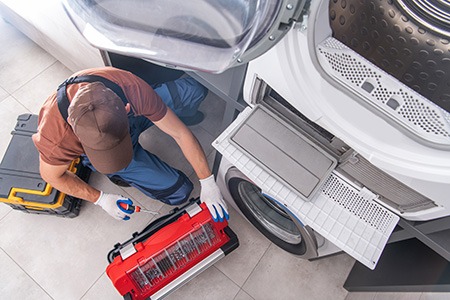
Your overheated dryer might be malfunctioning due to a dysfunctional heating element. This appliance component superheats the air before sending it to the drum, where it dries your clothing. The element can dislodge or buckle, shorting to the ground and causing the part to fail to activate or not turn off.
Most machines feature a single or dual coil located in the heating box. These coils can also malfunction, causing an overheating issue. Use the following method to assess the heating element and coils.
- Disconnect the dryer from the power supply.
- Locate the heating element behind the drum, inside the cabinet.
- Disconnect the wires from the heating element.
- Use your multimeter to assess its function.
Place the multimeter probe on the heater box and separately test the terminals with the other probe. If the terminals show continuity, they're grounded, and you'll need to replace them. You can conduct a test for a dual coil heating element similarly.
Tip #2 – Examine the Blower Wheel
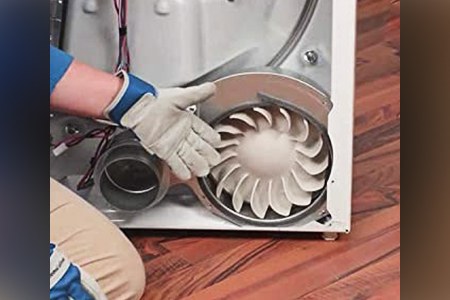
A clogged or faulty blower also causes the machine the malfunction and lead to a dangerous squeaky dryer. Follow this process to check the blower wheel.
- Disconnect the blower from the power supply.
- Locate the blower wheel behind the front or rear panel inside the housing.
- Check it's not clogged.
- Check the blower wheel for damage and secure attachment to the motor shaft.
If the blower wheel is not spinning properly or there are signs of damage, it might cause the overheating issue because it's not restricting airflow into the drum. To check, spin the blower, and you should notice the motor and drum turn. You'll need to buy and fit a replacement part if it doesn't turn.
Tip #3 – Check the Ventilation Duct for Blockages
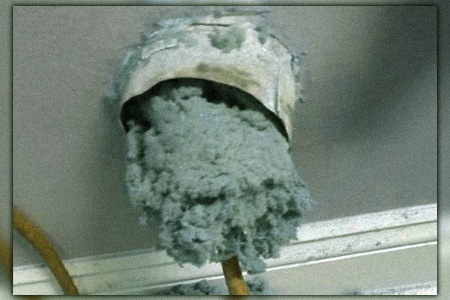
Blocked ventilation is one of the more common causes of your dryer overheating. If the warm air can't escape through the ventilation duct, it gets trapped in the drum, which causes overheating. You might find a kink in the exhaust hose restricting the airflow.
Pet hair and lint can cause ventilation blockages, too. Ensure you clean the lint trap regularly to prevent it from happening. Follow this process to check if there's a ventilation blockage causing the problem.
- Disconnect the dryer from the power supply.
- Disconnect the exhaust hose from behind the dryer.
- Use a vacuum attachment or cleaning kit to clean the ventilation duct and exhaust hose.
After cleaning the duct, ensure the vent flapper isn't clogged and is working properly. And please, don't vent your dryer into your garage. If you don't have a vent in your laundry room you can still vent the dryer outside following some of our advice here.
Tip #4 – Look for a Faulty Thermostat
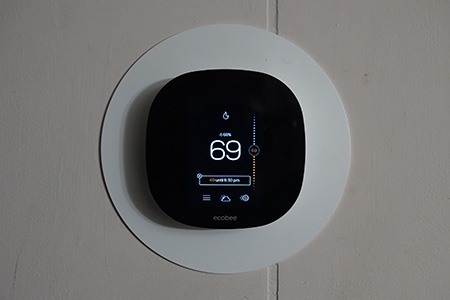
This is a common reason when people complain their dryer is getting too hot. The thermostat controls the heat inside the dryer, ensuring it doesn't get too hot. If the thermostat senses the heat rising beyond a set temperature of 180 degrees Fahrenheit, it shuts down the heating coil.
If faulty, it won't cut off the heating element at the required temperature, causing overheating in the appliance. Follow this process to assess the thermostat.
- Disconnect the dryer from the power supply.
- You'll find the thermostat on the blower housing or near the heating source.
- Remove the connectors.
- Take the thermostat off the heating element and test it with a multimeter for continuity.
You can test the temperature using a heat gun. Heat it slowly to get a correct reading. Once it moves past the rated temperature for the appliance, if it loses continuity, that lets you know you need to replace it. The correct temperature should be mentioned on the thermostat, but if not expect it to be around a range of 140-160 degrees Fahrenheit.
Tip #5 – Assess the Thermistor
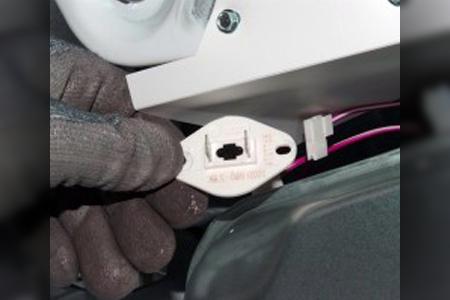
The thermistor is a component of new-generation dryers with control boards. The thermistor regulates the temperature along the control board. A malfunctioning thermistor sends the incorrect resistance load to the control board, causing the appliance to overheat.
Check the dryer operating manual and see if there's a diagnostic mode for testing the thermistor. Follow these guidelines for testing the thermistor.
- Disconnect the dryer from the power supply.
- Locate the thermistor on the blower housing.
- Check the operating manual for the correct temperature and resistance reading chart.
Locate the correct ohm range for the thermistor and test it with your multimeter. If the reading is incorrect, you'll need to replace the thermistor. It's also important to note that the ambient temperature in the room can affect the reading.
Tip #6 – Inspect the Cycling Thermostat Contacts
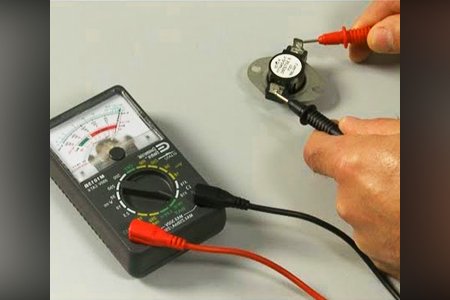
The cycling thermostat can also cause overheating in the appliance. This component regulates heat inside the dryer, cycling it on and off. If the contacts become fused, it causes overheating. Use the following procedure to check the cycling thermostat.
- Disconnect the dryer from the power supply.
- Locate the cycling thermostat on the blower housing or near the heat source.
- Unscrew it from the dryer.
- Locate the cycling thermostat's rated temperature in the operating manual.
Most cycling thermostats have an operating temperature between 135-165 degrees Fahrenheit. Use your multimeter to test for continuity by attaching the probes to the terminals. Some models have cycling thermostat bias heaters as part of the cycling thermostat.
You'll see the larger terminals controlling the cycling thermostat. Test its continuity after the appliance heats up. You can use a hair blow dryer to heat it. Don't warm it up fast, as this causes incorrect readings.
Take a steady approach and keep the blow dryer around six inches from the terminals. If it loses continuity past the rated temperature, the contacts are fused and need replacement.
Tip #7 – Look for a Faulty Cycling Thermostat Bias Heater
The cycling thermostat bias heater permits several temperature settings with a single cycling thermostat. It's important to note not all appliances will feature a cycling thermostat bias heater. If this component is dysfunctional, it causes the lower temperature settings to run (perhaps much) hotter than they should.
Follow this process to assess the cycling thermostat bias heater.
- Disconnect the dryer from the power supply.
- Locate the bias heater. You'll find it's built into the cycling thermostat.
- Locate the two smaller terminals on the cycling thermostat.
Check your wiring diagram in the operating manual (if available) and find the bias heater's specific ohm rating. Use your multimeter and set it to read the ohm range of the bias heater. If the reading from the multimeter isn't within the specified range, it needs replacement.
4 Ways to Prevent Your Dryer from Overheating
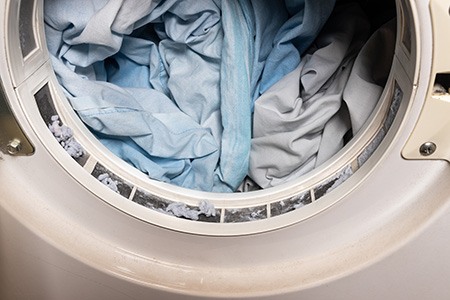
The best move is to avoid the problem of an overheating dryer in the first place. With a few simple maintenance methods and a little bit of conscientiousness, you can dodge the problem in most cases altogether.
Method #1 – Don't Overload the Machine
The more clothes in the dryer, the more heat the dryer needs to generate to complete the cycle. Overloading the dryer with clothes causes it to overheat, exhausting the heating element. Overloading the appliance also causes overstimulation of the sensors in the drum.
The excess weight in the tumbling action due to overloading can damage the sensors, causing them to fail to identify the increasing temperature, resulting in overheating. Uneven drying from drying shoes in the dryer can do this, as well.
Method #2 – Clean Out the Filter & Lint Trap
If the ventilation and air circulation in the dryer experience blockages or limitations, it presents a fire hazard. Lint buildup clogs the air pathway, causing heat buildup in the duct, leading to your dryer overheating and shutting off.
Clean the lint filter after every use of the machine; it only takes a few seconds and reduces the risk of overheating and fires. You'll find the lint filter toward the front of the dryer or on the door, and it's easy to remove.
We recommend cleaning the exhaust vent on the inside and outside of your home to prevent blockages that present fire risks to the appliance. Disconnect the exhaust tube every month and vacuum it out.
Sometimes you'll find two slats in the ducting outdoors that require removal and cleaning. Remove any grass, leaves, or debris blocking airflow through the outdoor duct.
Method #3 – Dust & Clean Behind the Dryer
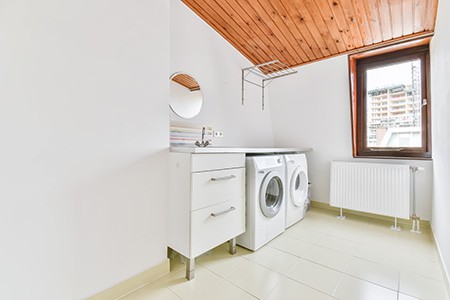
Cleaning behind the dryer is an easy maintenance step to keep the appliance working properly. Dust and lint build up around inlet vents after multiple cycles. Having your appliances seated on washer and dryer pedestal alternatives can help keep them away from the dust that settles on the ground.
These vents are typically found on the rear and underside of the appliance. Use a long-handled duster to clean the incoming air duct and remove the buildup every other week. This is especially important if you have a dusty cat litter box in the laundry room.
Dust not only restricts air flow but acts as insulation on the hot components themselves. If your dryer overheats, this is a first step to take, for sure.
Method #4 – Clean the Dryers Vent Exhaust
Clear the outside vent exhaust. You'll find the two slats in the outdoor duct, remove them, and clean them every other week. Remove any built-up debris that limits the flow of air exiting the machine. Make sure no birds have made nests in the cavity and that there's no other obstructions.
If Your Dryer is Overheating, Check Your Warranty
If your dryer is overheating, check your warranty. Chances are you don't have the technical skills to complete the checks listed in this post and you can have it solved at no expense.
If the dryer is still under warranty, send it back to the manufacturing company for servicing and repair. Call a professional appliance service center for assistance if it's out of warranty.
Additionally, remember to maintain your machine to the proper standard. Preventative maintenance goes a long way to safeguarding against fires and preventing damage to the appliance. The big reasons for a dryer overheating can be caused by you not doing some basic maintenance chores, and that's an easy fix!



